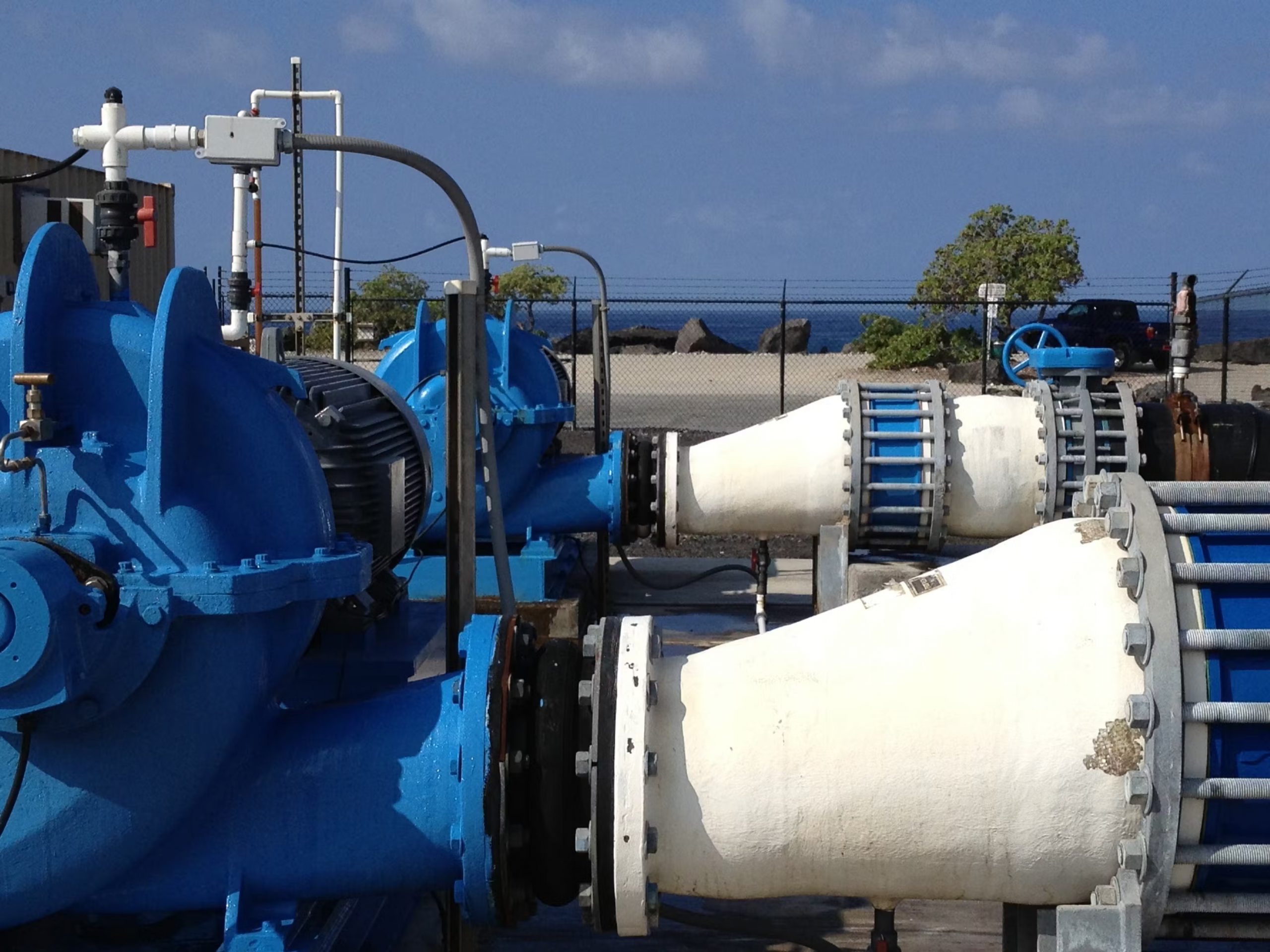Menu

NEWS
International Partners Pursue AI-Based Microgrid Research at Saltwater Pumping Facility
enertalk_energy
2021-04-28 10:00
작성일 : 2021.04.28.
An unusual group of partners from the Republic of Korea and Hawaii are conducting microgrid research at a saltwater pumping facility in Hawaii, with a goal of using artificial intelligence (AI) to help boost the efficiency of the existing power system by 30% when it is off-grid because of utility outages.
Lisa Cohn

The project, expected to be completed by mid-2022, will benefit both Hawaii and the Republic of Korea through the development of green energy technologies. Two million dollars in funding comes from the Korea Energy Technology, Evaluation and Planning Institute (KETEP), which funds international cooperation and testing of Korean technology in foreign locations.
The microgrid, with 500 kW of PV, 750 kWh of battery storage and an existing diesel generator, will be located at the Hawaii Ocean Science and Technology Park, where the Natural Energy Laboratory of Hawaii Authority (NELHA) operates the world’s largest seawater utility in an isolated island environment. It’s seen as a perfect test bed for the research that’s taking place because it has a 24/7 load and is located in an area with high levels of solar penetration, said Gregory Barbour, executive director of NELHA.
Right now, the pumping station has 200 kW of PV and no storage. The load is 600 kW and most of the electricity for the station comes from the grid, said Barbour. A diesel backup generator serves the pumping station when the grid is down.
The Korean government helped pay to build the test bed site and uses it to conduct research at the pumping station, which pumps 30 million gallons of seawater a day from 3,000-foot depths for use by commercial entities such as an abalone farm.
Along with NELHA, which will receive free electricity once the microgrid is built, the partners include the University of Hawaii’s Hawaii Natural Energy Institute (HNEI) and LG Electronics, which is headquartered in South Korea and will provide the battery. Other partners are Encored, KETEP, Coast Energy Capital Fund, Seoul National University and Gwangju Institute of Science and Technology.
The partnership began with the efforts of Mark Glick, an energy policy and innovation specialist at the University of Hawaii’s HNEI and former administrator of the Hawaii State Energy Office, where he led Hawaii’s clean energy transformation efforts.
“An initial programmatic focus when I came to the University of Hawaii in early 2017 was to seek mission innovation research and demonstration funding from the Republic of Korea for renewable microgrid applications in Hawaii,” said Glick.
When Glick was Hawaii’s energy administrator, he had discussions with contacts from Seoul National University to help establish a cooperative agreement between Hawaii and KETEP.
“Since smart grid and microgrid markets in the United States were a KETEP funding priority, my objective was to conduct a feasibility study on Hawaii sites, which, if successful, would be eligible for follow-on funding to demonstrate the technology,” said Glick.
As a result of Glick’s early efforts, the $4 million project will be funded with the $2 million from KETEP plus financing from Coast Energy Capital, said Brian Lynch, managing director at Coast Energy Capital, which will build, own and operate the project. Coast Energy Capital will optimize the use of the federal investment tax credit and Hawaii tax credits, as well as depreciation, to pull together the money needed to move the project forward.
Hyoseop Lee, chief strategy officer at Encored, said that the project will yield less downtime, lower operational costs and lower energy costs than existing costs through the utility. For example, Encored’s system will use data analytics to cut the pumping station’s peak energy use and the costs associated with that.
The data-based AI system also provides predictive warnings. “The system gives predictions so we can get early warnings and reduce downtime and make some corrections,” said Jin Lee.
Learn more about cutting edge microgrids at “What’s Next in Microgrid Tech?,” 1 pm, May 27, at Microgrid 2021: The World Awakens to Microgrids, a free virtual conference hosted by Microgrid Knowledge.
For Barbour, siting the project on NELHA’s property means that the research lab will have free electricity for years to come and gain — along with the other partners — additional benefits.
“This project will assist us in achieving our goal of becoming carbon neutral by 2030,” said Barbour. When the project is complete, NELHA will generate about 35% of its total power needs from renewables. “In addition, this project will continue to increase the brand of our ocean science and technology park as a perfect demonstration site for advanced energy projects,” he added.
#iDERMS_MG, #iDERMS_VPP, #iDERMS_PPC, #ENCORED_GENERAL, #LANG_EN
An unusual group of partners from the Republic of Korea and Hawaii are conducting microgrid research at a saltwater pumping facility in Hawaii, with a goal of using artificial intelligence (AI) to help boost the efficiency of the existing power system by 30% when it is off-grid because of utility outages.
Lisa Cohn

Pump station photo courtesy NELHA
An unusual group of partners from the Republic of Korea and Hawaii are conducting microgrid research at a saltwater pumping facility in Hawaii, with a goal of using artificial intelligence (AI) to help boost the efficiency of the existing power system by 30% when it is off-grid because of utility outages.The project, expected to be completed by mid-2022, will benefit both Hawaii and the Republic of Korea through the development of green energy technologies. Two million dollars in funding comes from the Korea Energy Technology, Evaluation and Planning Institute (KETEP), which funds international cooperation and testing of Korean technology in foreign locations.
The microgrid, with 500 kW of PV, 750 kWh of battery storage and an existing diesel generator, will be located at the Hawaii Ocean Science and Technology Park, where the Natural Energy Laboratory of Hawaii Authority (NELHA) operates the world’s largest seawater utility in an isolated island environment. It’s seen as a perfect test bed for the research that’s taking place because it has a 24/7 load and is located in an area with high levels of solar penetration, said Gregory Barbour, executive director of NELHA.
Right now, the pumping station has 200 kW of PV and no storage. The load is 600 kW and most of the electricity for the station comes from the grid, said Barbour. A diesel backup generator serves the pumping station when the grid is down.
Increases microgrid efficiency
The project will yield numerous benefits, according to Jin Lee, chief marketing officer for Encored, a California based energy AI and big data company. “Our system provides efficiency increases for the island mode and also demand charge reduction for the grid-tied operation,” he said.The Korean government helped pay to build the test bed site and uses it to conduct research at the pumping station, which pumps 30 million gallons of seawater a day from 3,000-foot depths for use by commercial entities such as an abalone farm.
Along with NELHA, which will receive free electricity once the microgrid is built, the partners include the University of Hawaii’s Hawaii Natural Energy Institute (HNEI) and LG Electronics, which is headquartered in South Korea and will provide the battery. Other partners are Encored, KETEP, Coast Energy Capital Fund, Seoul National University and Gwangju Institute of Science and Technology.
History of project
The project is the outgrowth of a 2015 memorandum of understanding between the state of Hawaii and KETEP that aims to benefit both parties in the development of green energy technology.The partnership began with the efforts of Mark Glick, an energy policy and innovation specialist at the University of Hawaii’s HNEI and former administrator of the Hawaii State Energy Office, where he led Hawaii’s clean energy transformation efforts.
“An initial programmatic focus when I came to the University of Hawaii in early 2017 was to seek mission innovation research and demonstration funding from the Republic of Korea for renewable microgrid applications in Hawaii,” said Glick.
When Glick was Hawaii’s energy administrator, he had discussions with contacts from Seoul National University to help establish a cooperative agreement between Hawaii and KETEP.
“Since smart grid and microgrid markets in the United States were a KETEP funding priority, my objective was to conduct a feasibility study on Hawaii sites, which, if successful, would be eligible for follow-on funding to demonstrate the technology,” said Glick.
As a result of Glick’s early efforts, the $4 million project will be funded with the $2 million from KETEP plus financing from Coast Energy Capital, said Brian Lynch, managing director at Coast Energy Capital, which will build, own and operate the project. Coast Energy Capital will optimize the use of the federal investment tax credit and Hawaii tax credits, as well as depreciation, to pull together the money needed to move the project forward.
AI optimizes microgrid resources
One of the keys to boosting the efficiency of the existing diesel backup generator is to use AI to optimize the project’s solar, storage and diesel generator, said Lee of Encored. The company’s AI technology will help the solar, storage and diesel work collectively to improve the efficiency of providing off-grid electricity by 30%.Hyoseop Lee, chief strategy officer at Encored, said that the project will yield less downtime, lower operational costs and lower energy costs than existing costs through the utility. For example, Encored’s system will use data analytics to cut the pumping station’s peak energy use and the costs associated with that.
The data-based AI system also provides predictive warnings. “The system gives predictions so we can get early warnings and reduce downtime and make some corrections,” said Jin Lee.
Learn more about cutting edge microgrids at “What’s Next in Microgrid Tech?,” 1 pm, May 27, at Microgrid 2021: The World Awakens to Microgrids, a free virtual conference hosted by Microgrid Knowledge.
For Barbour, siting the project on NELHA’s property means that the research lab will have free electricity for years to come and gain — along with the other partners — additional benefits.
“This project will assist us in achieving our goal of becoming carbon neutral by 2030,” said Barbour. When the project is complete, NELHA will generate about 35% of its total power needs from renewables. “In addition, this project will continue to increase the brand of our ocean science and technology park as a perfect demonstration site for advanced energy projects,” he added.
#iDERMS_MG, #iDERMS_VPP, #iDERMS_PPC, #ENCORED_GENERAL, #LANG_EN
출처 : MICROGRID KNOWLEDGE
